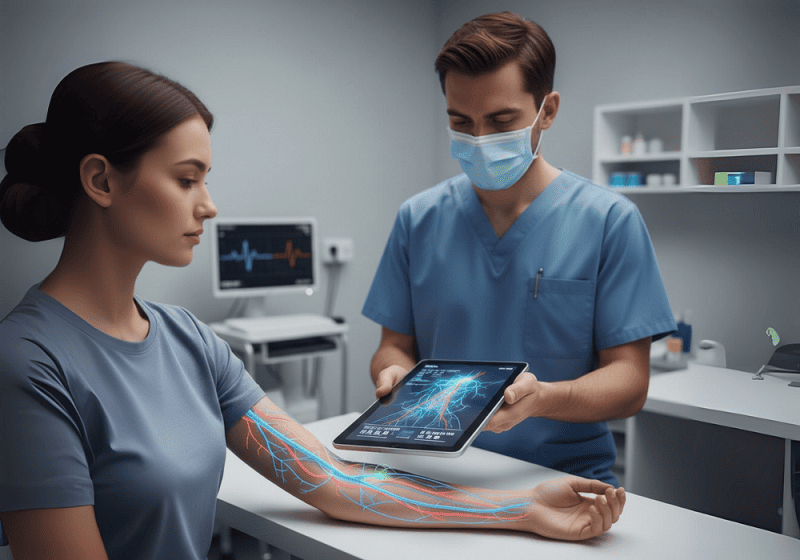Introduction
Finding veins for IV insertion, blood draws, or cosmetic procedures can be challenging. Patients with dark skin, obesity, or fragile veins often pose difficulties even for experienced healthcare professionals. This is where augmented reality vein finders come into play.
An augmented reality vein finder uses near-infrared technology and projection systems to visualize veins directly on the skin, helping clinicians locate veins faster and more accurately. In this guide, we’ll explore the technology behind these devices, review leading products, discuss pros and cons, provide comparisons, and answer common augmented reality questions and answers for beginners.
For those looking to deepen their understanding, we’ll also highlight recommended augmented reality books covering the science and applications of AR. By the end of this article, you’ll know how to choose the right vein finder, understand its limitations, and discover resources for learning more about augmented reality.
1. How Augmented Reality Vein Finders Work
1.1 Fundamental Principles: Near-Infrared & Projection
Augmented reality vein finders rely on near-infrared (NIR) light. NIR light penetrates the skin and is absorbed differently by deoxygenated blood, creating a contrast between veins and surrounding tissue. A sensor captures this reflected light and converts it into an image, which is then projected back onto the skin using a micro-projector or display system.
Key points:
- The projection aligns with the skin to accurately show vein locations.
- 3D reconstruction helps adjust for body contours, ensuring precision.
- This technology is non-invasive and provides real-time visualization.
For a deeper understanding of AR principles, readers can refer to an augmented reality book covering medical imaging applications, sensor integration, and projection techniques.
1.2 Types of AR Vein Finder Devices
- Handheld projection-based AR vein finders: Portable, often used in hospitals and clinics.
- Mobile / smartphone-based AR apps: Apps like VeinSeek Pro turn your phone into a vein finder using the camera and AR overlay.
- Hybrid systems: Combine a camera and micro-projector for precise projection, e.g., NextVein.
- Cart-mounted or fixed systems: High-end hospital models for continuous use in critical care.
1.3 Technical Challenges & Limitations
While AR vein finders are effective, they have limitations:
- Alignment issues or parallax errors can reduce accuracy.
- Skin tone, fat thickness, tattoos, or hair may affect visibility.
- Depth limitations: generally only veins up to 10 mm below the skin are visible.
- Devices require calibration and proper lighting.
- High-end devices can be costly and require maintenance.
2. Leading Devices & Apps for Finding Veins
2.1 AccuVein AV500
- Portable, handheld near-infrared device.
- Projects green lines of veins on the skin.
- No calibration required; works at 6–10 inches distance.
- Uses class 1 laser; suitable for pediatrics and geriatrics.
- Portable AR device ideal for blood draws and IV insertions.
- Fast scanning, multi-color display, hands-free operation.
- Reported high first-stick success rate.
2.3 NextVein System
- Uses camera + micro-projector for precise AR overlay.
- Digital alignment reduces projection errors.
- High accuracy for hospital and clinical settings.
2.4 VeinSeek Pro / VeinScanner Pro (App-Based)
- VeinSeek Pro: AR app turns smartphone camera into a vein viewer.
- VeinScanner Pro: adds zoom and simulated infrared processing.
- Limitations: dependent on smartphone camera quality and lighting.
2.5 Other Notable Devices
- VeinLite LED / VeinLite series: Transillumination + vein viewing.
- Illumivein: budget, portable option.
- VeinViewer (AVIN / Christie): Projector-based IR devices for hospitals.
3. Use Cases & Applications
3.1 Clinical & Hospital Settings
- IV access, blood draws, emergency care.
- Pediatrics, oncology, and geriatric patients.
- Reduces failed attempts and patient discomfort.
3.2 Cosmetic & Aesthetic Procedures
- Locating veins for dermal fillers or sclerotherapy.
- Avoids accidental vascular injection.
3.3 Home Health & Self-Administered Use
- For patients requiring frequent injections (diabetes, fertility treatments).
- Emphasize safety: professional guidance recommended.
3.4 Training & Education
- Nursing and medical school simulations.
- Helps students practice vein access without risk to patients.
4. Pros and Cons
4.1 Pros
- Higher first-stick success.
- Reduced patient pain and anxiety.
- Faster vein location.
- Non-invasive, real-time guidance.
4.2 Cons
- Limited to superficial veins (~10 mm depth).
- Alignment and parallax errors possible.
- Performance affected by skin tone, lighting, and fat.
- Higher cost for premium devices.
4.3 Key Considerations
- Device depth capability and projection alignment.
- Calibration needs, ease of use, and portability.
- Maintenance and software updates.
5. Comparative Analysis: AR vs Traditional Vein Finders
5.1 Traditional Methods
- Palpation and visual inspection.
- Transilluminators (light through tissue).
- Ultrasound guidance for deeper veins.
5.2 Advantages of AR
- Direct overlay, intuitive guidance.
- Faster than palpation.
- Reduces failed attempts.
5.3 Limitations
- Deep veins still require ultrasound.
- AR is an adjunct, not a replacement for traditional methods.
6. How to Select & Implement an AR Vein Finder
6.1 Needs Assessment
- Patient demographics and vein difficulty.
- Volume of IV procedures.
- Budget and staff training requirements.
6.2 Pilot Testing
- Trial multiple devices.
- Measure first-stick success rates.
- Collect staff feedback.
6.3 Training & Integration
- Teach proper scanning and projection alignment.
- Standardize workflow for consistency.
6.4 Maintenance
- Regular calibration and firmware updates.
- Device upkeep according to manufacturer instructions.
7. Future Trends & Innovations
- AI-enhanced vein segmentation.
- AR glasses and wearable devices for vein visualization.
- Consumer-grade apps with better depth simulation.
- Hybrid AR + ultrasound systems.
- Research continues on using augmented reality book resources for training and technical insights.
8. FAQs
Device projecting vein map onto skin using NIR and AR.
Up to 10 mm deep; accuracy varies with skin tone and fat.
Yes, apps like VeinSeek Pro and VeinScanner Pro.
Depends on setting: AccuVein, Hellovein, NextVein are popular.
Superficial veins, typically up to 10 mm.
Not entirely; AR is best for mapping, ultrasound for depth.
Alignment issues, lighting, skin tone, depth limits.
Handhelds: $500–$2,000; hospital-grade: $5,000+.
Yes, for fillers, sclerotherapy, and other procedures.
Recommended textbooks on AR, medical imaging, and projection technologies.
9. Conclusion
Augmented reality vein finders offer faster, more precise vein location for clinicians, educators, and home health users. While limitations exist, such as depth restrictions and alignment challenges, AR devices significantly improve patient outcomes.
For deeper learning, consider an augmented reality book or online augmented reality questions and answers resources. Explore other guides on medical device innovation and digital healthcare to stay ahead in this evolving field.
10. Disclaimer
All information is based on publicly available sources, product websites, research articles, and reviews. This content is for informational purposes only and should not be considered medical advice. Readers should consult healthcare professionals before using any devices or apps mentioned. The publisher is not responsible for accuracy, completeness, or use of the information.













Recent Comments